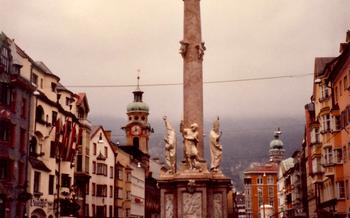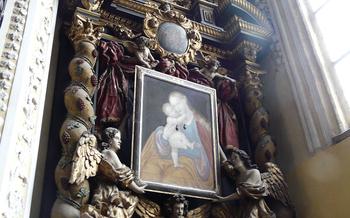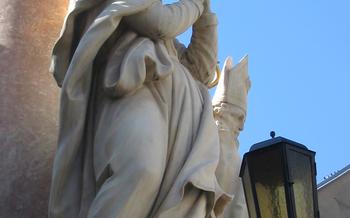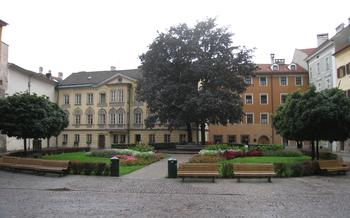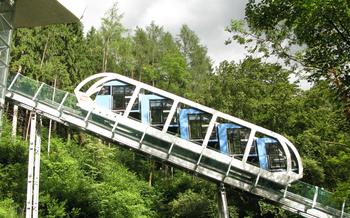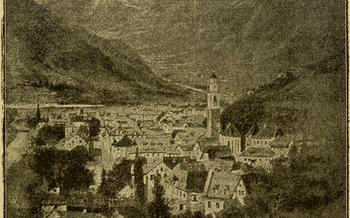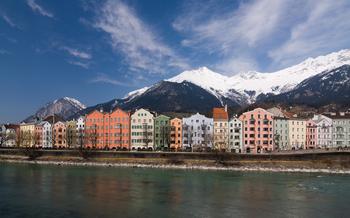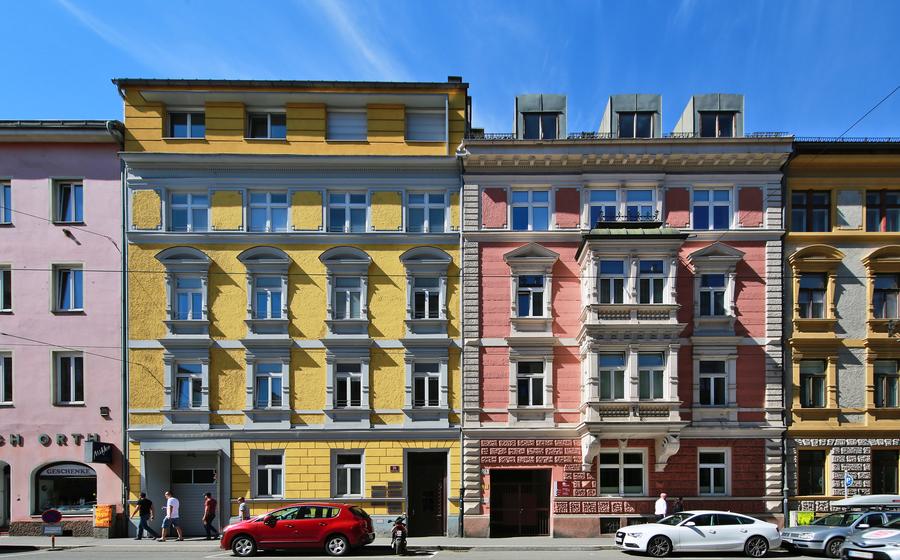
The Historic Old Town
- The Golden Roof
- Hofkirche (Court Church)
- History and significance
- Detailed description
- Anecdotes
- Practical information
- The Imperial Palace Gardens: A Royal Haven in the Heart of Innsbruck
- The Triumphal Arch
- The Alpine Zoo Innsbruck
- The Nordkette Mountains: A Majestic Alpine Wonderland
- The Bergisel Ski Jump
- Insider Tip: The Hidden Gem of Innsbruck
The Golden Roof
The Golden Roof, or Goldenes Dachl in German, is one of Innsbruck's most iconic landmarks. Located in the heart of the Old Town, this magnificent late Gothic masterpiece was built in the 15th century by Emperor Maximilian I to commemorate his marriage to Bianca Maria Sforza.
The roof is made of 2,657 fire-gilded copper tiles and is intricately decorated with reliefs depicting scenes from the emperor's life and reign. It is considered one of the finest examples of Gothic architecture in Europe and has become a symbol of Innsbruck.
Throughout history, the Golden Roof has been used for a variety of events, including courtly festivities, tournaments, and religious ceremonies. It was from this balcony that Emperor Maximilian I famously watched jousting tournaments in the square below.
Today, the Golden Roof is a popular tourist attraction and offers visitors a glimpse into the grandeur of the Habsburg era. Guided tours are available, providing visitors with insights into the history and significance of this remarkable structure.
Practical information:
- Location: Herzog-Friedrich-Strasse 15, 6020 Innsbruck, Austria
- Accessibility: The Golden Roof is located in the pedestrian zone of the Old Town and is easily accessible on foot.
- Opening hours: Daily from 10 am to 5 pm.
Hofkirche (Court Church)
History and significance
The Hofkirche, or Court Church, is one of Innsbruck's most significant and beautiful churches. It was built in the 16th century by Emperor Maximilian I as his final resting place. The church is a stunning example of Gothic architecture, with a soaring nave, intricate stained glass windows, and a magnificent high altar.
Detailed description
The Hofkirche is a truly awe-inspiring sight. The exterior of the church is decorated with intricate carvings and sculptures, while the interior is filled with light and color. The nave is supported by slender columns, which create a sense of height and space. The stained glass windows depict scenes from the life of Christ and the Virgin Mary, and the high altar is a masterpiece of Renaissance art.
Anecdotes
The Hofkirche is a popular tourist destination, and many visitors are drawn to the church's unique history. One of the most famous stories about the Hofkirche is that Maximilian I's heart is buried in a separate urn from his body. This is because the emperor wanted his heart to be buried in the Netherlands, where he was born, but his body was buried in Innsbruck.
Practical information
The Hofkirche is located in the heart of Innsbruck, next to the Hofburg Imperial Palace. It is open to the public daily, and admission is free. Visitors can take a guided tour of the church, or simply explore the church on their own.
The Imperial Palace Gardens: A Royal Haven in the Heart of Innsbruck
History and Significance
The Imperial Palace Gardens, a verdant oasis nestled in the heart of Innsbruck, trace their roots back to the 16th century, when Archduke Ferdinand II commissioned their creation as a private retreat for the Habsburg imperial family. Designed by the renowned court gardener Giovanni Bapttista Castagna, the gardens were meticulously landscaped in the Italian Renaissance style, characterized by geometric patterns, symmetrical flower beds, and an abundance of fountains and statues.
Detailed Description
Strolling through the gardens, visitors are greeted by a symphony of colors and fragrances emanating from the meticulously manicured flowerbeds, which burst into bloom with vibrant hues throughout the year. The gardens are adorned with an array of statues, each telling a unique story from mythology or history. The central axis of the gardens is marked by the grand Neptune Fountain, a masterpiece of Renaissance sculpture that captures the majesty and power of the sea god.
Anecdotes
The Imperial Palace Gardens have played host to countless royal events, celebrations, and festivities over the centuries. In the 17th century, the gardens were transformed into a grand stage for lavish court balls and theatrical performances, attended by the Habsburg court and distinguished guests from across Europe. The gardens also served as a venue for diplomatic receptions and state banquets, where important alliances were forged and international relations were cultivated.
Practical Information
The Imperial Palace Gardens are located in the heart of Innsbruck, adjacent to the Hofburg Imperial Palace. They are open to the public daily, offering visitors a tranquil retreat from the bustling city center. The gardens are fully wheelchair accessible, and guided tours are available for those who wish to delve deeper into their rich history and symbolism.
The Triumphal Arch
Innsbruck's Triumphal Arch, also known as the Triumphbogen, stands as a grand testament to the city's rich history and artistic heritage. Erected in 1765, this imposing monument was commissioned by Empress Maria Theresa to commemorate the marriage of her son, Archduke Leopold, to Princess Maria Luisa of Spain.
The arch's design is a masterpiece of Baroque architecture, showcasing the intricate details and exuberant ornamentation characteristic of the period. Its three arches are flanked by colossal columns adorned with exquisite sculptures, depicting scenes from mythology and history. The central archway features a relief portraying the imperial couple, surrounded by allegorical figures representing the virtues of wisdom, justice, and strength.
The Triumphal Arch holds a special place in Innsbruck's folklore. Legend has it that the arch was built in just three days, thanks to the help of supernatural beings. The story goes that the empress, determined to have the arch completed in time for the wedding, made a pact with the devil, who agreed to finish the construction within the impossible deadline. However, the devil was outsmarted by a clever Innsbruck resident, who tricked him into thinking the sun had already risen, causing him to flee before the task was complete.
Today, the Triumphal Arch stands as a symbol of Innsbruck's imperial past and a reminder of the city's vibrant history. Located at the western entrance to the Old Town, it serves as a grand gateway for visitors to explore the city's many treasures.
The Alpine Zoo Innsbruck
A Haven for Alpine Creatures
Nestled amidst the awe-inspiring Tyrolean Alps, the Alpine Zoo Innsbruck offers a unique opportunity to encounter the enchanting world of alpine fauna. Established in 1962, this exceptional zoo is dedicated to preserving and showcasing the incredible biodiversity of the region's mountain ecosystems.
The zoo's beautifully landscaped grounds provide a natural habitat for a diverse array of alpine animals, including the majestic ibex, with its impressive horns and agile climbing abilities; the endearing marmots, known for their playful antics and social colonies; and the magnificent eagles, soaring effortlessly above the mountain peaks.
One of the highlights of the zoo is the opportunity to observe these fascinating creatures up close, gaining insights into their behavior and adaptations. Visitors can witness the ibex gracefully leaping across rocky terrain, marmots scurrying among the boulders, and eagles gliding effortlessly on the updrafts.
The Alpine Zoo Innsbruck also plays a crucial role in conservation efforts, actively participating in breeding programs for endangered alpine species. Through these initiatives, the zoo contributes to the preservation of the region's unique wildlife heritage and ensures the survival of these remarkable creatures for generations to come.
Practical Information:
- Location: Weiherburggasse 37a, 6020 Innsbruck, Austria
- Accessibility: Easily accessible by public transport (bus lines 3, 5, and W) or a short walk from the city center.
- Opening Hours: Daily from 9 am to 5 pm (last admission at 4 pm). Extended hours during the summer season.
The Nordkette Mountains: A Majestic Alpine Wonderland
History and Significance
The Nordkette Mountains, a breathtaking natural wonder, form the dramatic backdrop of Innsbruck, providing a stunning panorama that has captivated visitors for centuries. These mountains, with their towering peaks, lush valleys, and sparkling lakes, hold a special place in Tyrolean history and culture. Throughout the ages, they have served as a source of inspiration, adventure, and awe for locals and tourists alike.
Detailed Description
The Nordkette Mountains offer a diverse landscape that caters to every taste. Whether you're an avid hiker, a thrilling skier, or simply seeking tranquility amidst nature's beauty, these mountains have something for everyone. The region boasts a network of well-maintained hiking trails, winding through verdant forests, blooming meadows, and alongside crystal-clear alpine lakes. As you ascend, the views become increasingly breathtaking, revealing panoramic vistas that stretch for miles, showcasing the majesty of the surrounding peaks.
Anecdotes
The Nordkette Mountains have been a source of inspiration and wonder for generations. One of the most famous anecdotes associated with the mountains is the legend of the "Goldener Dachl," or Golden Roof, a magnificent landmark in Innsbruck's Old Town. According to legend, the roof was commissioned by Emperor Maximilian I, who was so enamored with the stunning views of the Nordkette Mountains from his palace that he wanted to share them with his subjects. Thus, the Golden Roof was built, allowing the emperor and his guests to enjoy the breathtaking panorama while attending court functions and festivities.
Practical Information
The Nordkette Mountains are easily accessible from Innsbruck, with a variety of transportation options available. The Nordkette cable car, a marvel of engineering in itself, whisks visitors up the mountainside, offering unparalleled views of the city and the surrounding peaks. Once at the summit, a world of adventure awaits, with hiking trails for all levels, from leisurely strolls to challenging alpine climbs. Ski enthusiasts can indulge in thrilling descents on the pristine slopes, while nature lovers can bask in the tranquility of the alpine meadows and sparkling lakes.
The Bergisel Ski Jump
A Leap into the History of Skiing and Breathtaking Views:
High above the city of Innsbruck, perched on the slopes of Bergisel Mountain, stands a symbol of winter sports prowess and breathtaking views. The Bergisel Ski Jump is an iconic landmark that has witnessed some of the most thrilling moments in ski jumping history.
The jump's origins date back to 1925, when it was first constructed as a wooden structure. Over the years, it has undergone several renovations and expansions, culminating in the current impressive steel structure that was unveiled in 200With a hill size of 130 meters and a spectator capacity of over 30,000, the Bergisel Ski Jump has become a renowned venue for both national and international ski jumping competitions.
What sets the Bergisel Ski Jump apart is not just its impressive dimensions but also its stunning location. Perched high above the city, it offers breathtaking panoramic views of Innsbruck and the surrounding Tyrolean Alps. Whether you're a ski enthusiast or simply seeking a unique vantage point to admire the beauty of the region, the Bergisel Ski Jump is a must-visit destination.
Insider Tip:
For an unforgettable experience, time your visit to coincide with one of the many ski jumping competitions or events held throughout the year. The atmosphere is electric, and you'll be able to witness world-class athletes soaring through the air with grace and precision.
Practical Information:
- Location: Bergiselweg 3, 6020 Innsbruck
- Accessibility: Easily accessible by public transport (bus line J) or on foot from the city center (approximately a 30-minute walk)
- Opening Hours: The ski jump is open to visitors during the summer season (May to October) with guided tours offered daily. During the winter season (November to April), the ski jump is primarily used for training and competitions, but visitors can still admire its impressive architecture from afar.
Insider Tip: The Hidden Gem of Innsbruck
Beyond the popular tourist attractions, Innsbruck holds a secret gem that offers a unique and authentic experience. Nestled amidst the charming streets of the Old Town, you'll find a hidden courtyard called Hofgarten, a serene oasis that invites you to step back in time.
This enchanting courtyard is adorned with beautifully preserved Renaissance architecture, featuring intricate frescoes and elegant arcades. The centerpiece of the Hofgarten is a tranquil fountain surrounded by lush greenery, creating a peaceful ambiance that transports you to a bygone era.
As you wander through the courtyard, you'll discover hidden corners and charming details that tell the story of Innsbruck's rich history. Admire the ornate doorways, the delicate carvings, and the faded inscriptions that hint at the lives that once unfolded within these walls.
Take a moment to sit on one of the benches and soak in the tranquility of the Hofgarten. Let the gentle sound of the fountain and the chirping of birds serenade you as you escape the hustle and bustle of the city.
This hidden gem is a perfect spot to savor a quiet moment of reflection or to simply relax and enjoy the beauty of Innsbruck's architectural heritage. If you're lucky, you might even catch a glimpse of a local artist capturing the essence of this magical place on canvas.
So, venture off the beaten path and discover the Hofgarten, a true hidden gem that will leave you with a lasting impression of Innsbruck's charm and history.
